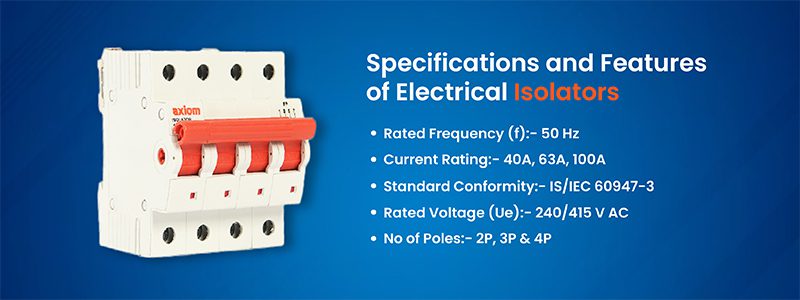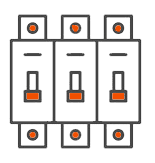
Describe the electrical isolator
A circuit can be physically isolated from its power source by using an electrical isolator, sometimes referred to as a disconnect switch or circuit breaker in electrical systems. For maintenance, repairs, or emergencies, it offers a way to securely de-energize and isolate a portion of an electrical circuit.
To successfully halt the flow of electrical current, an electrical isolator must be completely isolated from the circuit’s power source. This isolation is crucial for the safety of anybody working on the circuit or to prevent equipment damage when performing maintenance or repairs.
The electrical isolators are employed in what situations?
Electrical isolators are often used in industrial infrastructure, electrical panels and switchboards, renewable energy systems, power distribution networks, and other places.
It’s important to keep in mind that the particular use and requirements for electrical isolators may vary based on the sector, voltage range, and regulatory framework of different countries. Electrical engineers or experts with the necessary training must select, install, and use electrical isolators in certain situations.
Specifications and characteristics of electrical isolators
SALIENT CHARACTERS
Maximum energy efficiency is provided by the Electrical Isolator, which uses little electricity and is inexpensive. Due to their lengthy mechanical and electrical lifetimes, the isolators are dependable and made to last.
The convenience of low-watt loss, energy-efficient isolators provides a reliable and steady power supply. Axiom Isolators are an excellent choice for many applications because of their thoroughly thought-out design, which offers robust defence in a small package. Our premium solutions can assure you that you have spent your money on the finest.
TECHNICAL SPECIFICATIONS
- Standard Conformity:- IS/IEC 60947-3
- No of Poles:- 2P, 3P & 4P
- Current Rating:- 40A, 63A, 100A
- Rated Voltage (Ue):- 240/ 415 V AC
- Rated Frequency (f ):- 50 Hz
Common Issues and Solutions for Electrical Isolators
Electrical Isolators, like any other electrical component, may have several issues that may impair their performance. Here are some typical issues with electrical isolators and solutions, along with troubleshooting advice:
- Faulty connections: Poor electrical contact, increased resistance, overheating, or even failure can be caused by loose or corroded connections. Verify that every connection is well attached and corrosion-free. Periodically inspect and clean the terminals as necessary.
- Mechanical Wear: Isolators’ mechanical components may deteriorate with time, making them difficult to use or switching improperly. Replace worn-out parts right away and lubricate moving parts as directed by the manufacturer.
- Extreme arcing or tracking between switch contacts can harm the isolator and have an impact on its functionality. Look for burning, pitting, or carbon buildup on the connectors. Ensure appropriate contact alignment and clean or replace any broken contacts.
- Overheating: The isolator may become too hot if there is insufficient airflow or persistently high electrical loads. Make that the isolator is situated in an area with enough ventilation and is properly rated for the load it can carry. Look for any blockages or dust buildup that can prevent airflow.
- Failure of the Insulation: Insulation failure can cause leakage currents or short circuits. Check the insulation of the isolator on a regular basis for signs of wear & tear, fractures, or deterioration. Any damaged insulation should be replaced right away.
- Incorrect Operation: Incorrect operation, such as using the wrong switching order or exceeding the rated switching frequency, can cause harm to the isolator. Ensure operators receive the necessary training on the proper operating procedures and follow the manufacturer’s instructions.
Let’s say you keep running into problems with an electrical isolator that standard troubleshooting can’t fix. In that situation, it is advised to speak with a licenced electrician or get in touch with the manufacturer for more support. Always take safety precautions, and only authorized persons should handle isolators.













